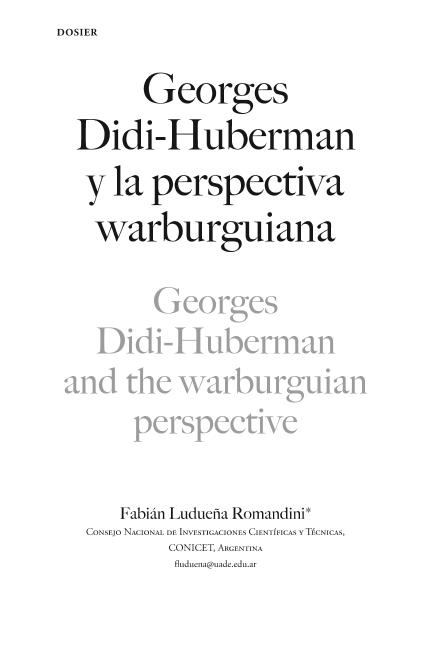Mostrar el registro sencillo del ítem
dc.contributor.author
Ludueña, Fabian Javier

dc.date.available
2022-08-16T14:45:48Z
dc.date.issued
2021-07
dc.identifier.citation
Ludueña, Fabian Javier; Georges Didi-Huberman y la perspectivawarburguiana; Universidad Iberoamericana; Revista de Filosofía; 53; 151; 7-2021; 16-52
dc.identifier.issn
0185-3481
dc.identifier.uri
http://hdl.handle.net/11336/165638
dc.description.abstract
El presente artículo propone un análisis de la influencia de la obra de Aby Warburg sobre el filósofo e historiador del arte Georges Didi-Huberman. Con este objetivo, se establece la hipótesis de una tríada conceptual decisiva en la interpretación del legado de Warburg que Didi-Huberman lleva adelante: la compleja y no dialéctica relación entre la “imagen-fantasma”, la “imagen-pathos” y la “imagen-síntoma”. Con acento en la “imagen-síntoma”, el texto presenta la hipótesis de la importancia de la experiencia de la locura para la comprensión de la obra conceptual de Warburg y se analiza el carácter prioritario que Didi-Huberman otorgó a este proceso. Finalmente, se identifica la gran apuesta de Didi-Huberman según la cual la obra de Warburg sobrepasa los límites de la historia del arte para transformarse en un desafío a la concepción evolucionista de la filosofía de la historia y la metafísica de la temporalidad.
dc.description.abstract
This article proposes an inquiry upon the influence of Aby Warburg’s oeuvre on
the philosopher and art historian Georges Didi-Huberman. Aiming this point, a
hypothesis establisheds a conceptual triad that is decisive in Didi-Huberman’s interpretation of Warburg’s legacy: that is, the complex and non-dialectical relationship
amongst the “image-phantom”, the “image-pathos” and the “image-symptom”.
Stressing the importance of the “image-symptom”, this study underlines the relevance of the experience of madness to understand Warburg’s conceptual heritage.
The article proceeds to analyze the pivotal character that Didi-Huberman assigned
to this process. Finally, Didi-Huberman’s crucial theoretical bet is identify through
his reading of Warburg. According to the French thinker, Warburg’s oeuvre goes
beyond the limits of art history to bid defiance to both the evolutionist conception
of the philosophy of history and the metaphysics of temporality.
dc.format
application/pdf
dc.language.iso
spa
dc.publisher
Universidad Iberoamericana
dc.rights
info:eu-repo/semantics/openAccess
dc.rights.uri
https://creativecommons.org/licenses/by-nc-sa/2.5/ar/
dc.subject
WARBURG
dc.subject
DIDI-HUBERMAN
dc.subject
NACHLEBEN
dc.subject
IMAGEN
dc.subject
LOCURA
dc.subject.classification
Otras Filosofía, Étnica y Religión

dc.subject.classification
Filosofía, Ética y Religión

dc.subject.classification
HUMANIDADES

dc.title
Georges Didi-Huberman y la perspectivawarburguiana
dc.title
Georges Didi-Huberman and the warburguian perspective
dc.type
info:eu-repo/semantics/article
dc.type
info:ar-repo/semantics/artículo
dc.type
info:eu-repo/semantics/publishedVersion
dc.date.updated
2022-08-16T12:05:51Z
dc.journal.volume
53
dc.journal.number
151
dc.journal.pagination
16-52
dc.journal.pais
México

dc.journal.ciudad
Ciudad de México
dc.description.fil
Fil: Ludueña, Fabian Javier. Consejo Nacional de Investigaciones Científicas y Técnicas; Argentina. Universidad de Buenos Aires. Facultad de Ciencias Sociales. Instituto de Investigaciones "Gino Germani"; Argentina
dc.journal.title
Revista de Filosofía
dc.relation.alternativeid
info:eu-repo/semantics/altIdentifier/url/https://revistadefilosofia.ibero.mx/index.php/filosofia/article/view/121
dc.relation.alternativeid
info:eu-repo/semantics/altIdentifier/doi/https://doi.org/10.48102/rdf.v53i151.121
Archivos asociados
